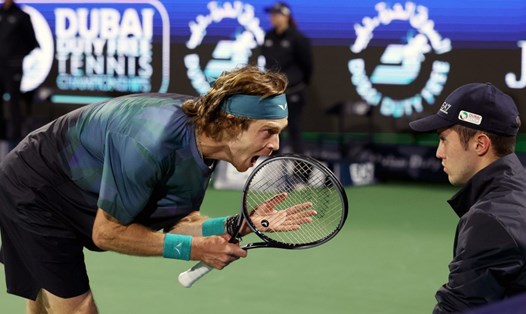Calls for VAR in tennis have exploded again in Cincinnati after a controversial end in Jack Draper's win in round 3.
The number one British tennis player reached the quarter-finals in Ohio after a 5-7, 6-4, 6-4 victory over Felix Auger-Aliassime.
However, that result was not the main concern of the match but the final score that created fierce controversy.
Accordingly, in the match-point, Draper seemed to have a technical hit to seal the victory with a spectacular comeback.
However, the re-entry image shows a very close situation, when the ball almost touches the racket and hits the ground at the same time before flying back to the other side of the net. The slower analysis showed that the ball hit the net first before hitting the ground, so the English player could not get a point.
When Draper celebrated, referee Greg Allensworth declared it a valid shot and declared Draper the winner, shocking Auger-Aliassime.
Both players cautiously headed towards the net, Auger-Aliassime protested the result before finally shaking hands with Draper.
"It's terrible that you've done that," the Canadian said in an interview with the referee.
"But you didn't see the ball floating on the floor? The ball hit his racket and bounced off the floor. You would see that image everywhere and look arrange.
This is not the first time this week that Allensworth has become the center of controversy after denying Taylor Fritz points in the match against Nakashima despite the ball going quite far, the hawkeye live technology also shows that.
At that time, through the discussion between Allensworth and Fritz, he said that the American tennis player did not stop at the right time when determining the ball out, while automatic technology did not report the right time.
And because of a technical mistake, the ball had to be hit back...
These latest controversial incidents have only caused a bigger explosion than the VAR debate in tennis. In fact, VAR has been used in the past at the Nitto ATP Finals and US Open but has not been deployed in the main tournament.
The problem is, even with VAR, the system is not yet complete. For example, at last year's US Open, in the first leg between Andy Murray and Corentin Moutin.
At that time, Moutin objected to a move in which the ball doubled, but the referee had difficulty reviewing it, the incident was considered ineffective.
After the match, Murray called it a advertising, because VAR in tennis is a system that allows players to protest against multiple decisions in a match, such as a hit or a double.
The system uses many different camera angles to get the best view of the incident and the VAR referee will send the video to the screen on the referee's seat and in the court. The referee will then review the video via tablet to determine whether the original decision was wrong and whether it should be canceled.
And earlier this year, Andrey Rublev was sent off for the Dubai Championships for being accused of insulting a line referee, despite his objections that he did not say so.
In such an unclear situation, the call for VAR in tennis is even stronger. But so far, there has been no sign that VAR will appear soon.
Maybe we have to wait for more controversies and more serious things like football! ?







